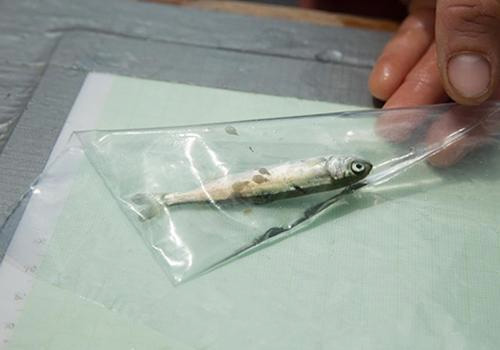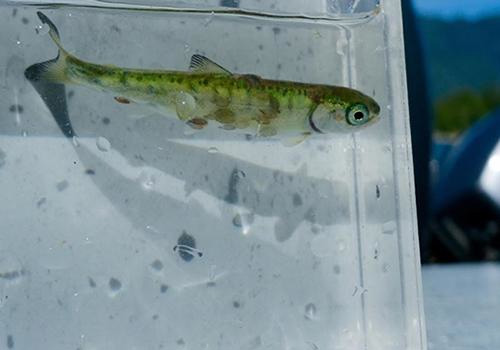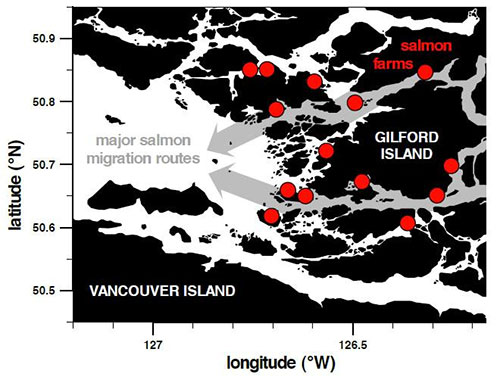
'Perfect storm' brought sea louse epidemic to BC salmon
July 26, 2016
The sea lice spread to migrating juvenile wild salmon, resulting in the highest numbers of sea lice observed on wild salmon in a decade. In spring of 2015, a team of U of T ecologists led by postdoctoral researchers Andrew Bateman and Stephanie Peacock found that more than 70 per cent of fish the team sampled in the Strait's Broughton Archipelago had at least one sea louse: the highest prevalence of such parasites since 2005.
A researcher 'live-lousing' a juvenile pink salmon that will be released to continue its seaward migration.
Because farmed salmon are in open net pens and share water with nearby wild salmon, the parasites can transmit to young wild salmon who wouldn't normally encounter sea lice until later in life. These young fish are sometimes as small as three centimetres in length, while sea lice themselves can be close to one centimetre in diameter. "Getting sea lice at such an early age affects young salmons' health and their ability to fend off predators," says Peacock. Based on the numbers of lice on juvenile salmon in 2015, researchers predicted an additional 9 - 39 per cent decline in returning pink salmon due to the outbreak. In order to determine the cause of this outbreak, the team assessed the evidence for four contributing factors:
"Even though parasite treatments on farms were effective, we saw that treatments failed to protect wild salmon, and this happened at a time of unexpected warming in ocean water in these regions," says Martin Krkosek, assistant professor in U of T's Department of Ecology & Evolutionary Biology. Krkosek was Bateman's and Peacock's supervisor and study co-author.
A juvenile chum salmon infested with sea louse parasites.
Also in 2015, individual salmon farms did not coordinate anti-louse treatments, with some farms delaying treatment until just prior to the time when juvenile salmon migrate past farms. As a result, sea lice from those farms could have spread to adjacent farms, hampering area-wide control of the outbreak. "Furthermore, during the juvenile wild salmon migration, farms are supposed to treat for sea lice within 15 days of when a threshold number of lice are found on adult farmed salmon," says Peacock. "But in 2015, some farms waited several months before they treated." "The strategy might have been 'wait until the migration to treat' but it kind of backfired because the louse populations were allowed to grow in the meantime, and the lice spread to other nearby farms. It likely created a bigger problem down the road." "We were surprised to see that some farms don't seem to be following their license conditions," says Peacock. "We thought maybe there were more infractions in 2015 that may have led to higher numbers of sea lice, but when we looked back over 10 -15 years, the rate of such infractions was about the same. The big difference in 2015 really seems to be the combination of a lack of proactive parasite treatment and higher water temperatures."
Map showing salmon farm locations and major wild salmon migration routes in BC's Broughton Archipelago.
"Sea lice used to be a problem a decade or so ago, then parasite management changed and it seemed like the problem had been effectively managed for several years. Then it wasn't managed well all of a sudden," says Krkosek. "This is a lesson about the importance of better coordinating and timing regional treatment and being aware of warming ocean temperatures." The results of the team's study appear in a paper published in the July edition of the Canadian Journal of Fisheries and Aquatic Sciences. This work was supported by Natural Sciences and Engineering Research Council (NSERC) and Killam postdoctoral fellowships to Bateman, an NSERC Discovery Grant to Mark Lewis at the University of Alberta that supported Peacock, an NSERC Discovery Grant and Sloan Fellowship to Krkosek, a Global Greengrant from the Marisla Foundation, and an infrastructure grant from the Pacific Salmon Foundation.
On the Web:
Edited by Mary Kauffman, SitNews
Source of News:
To comment, Readers now have the option to provide Comments, Opinions, & Responses on the new easy to use SitNews' auto-post webpage or... Readers may continue to use the FaceBook response section provided below. Representations of fact and opinions in comments posted are solely those of the individual posters and do not represent the opinions of Sitnews.
|
||||



